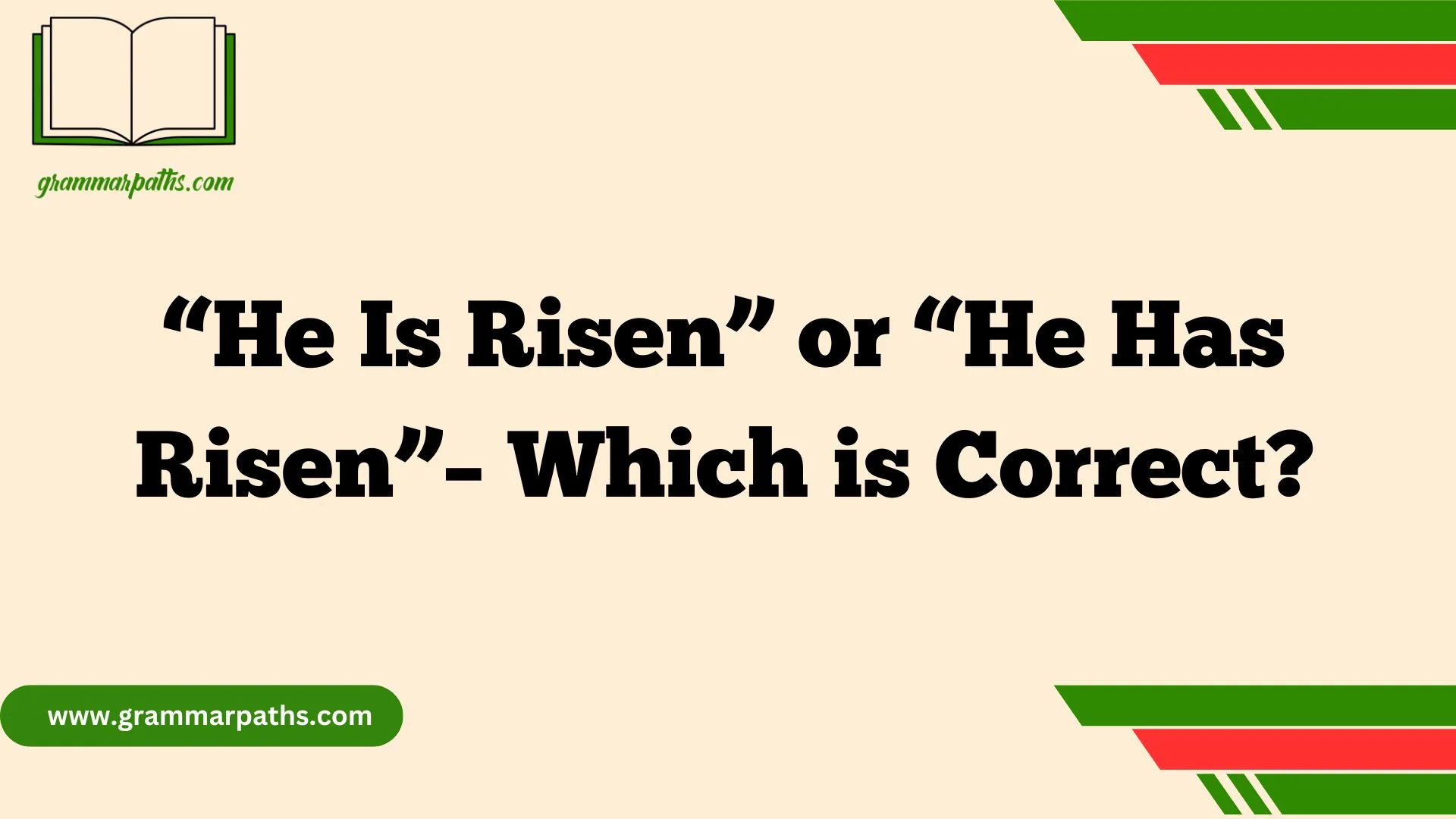“He Is Risen” or “He Has Risen” – Which is Correct? This is a question that often arises during Easter celebrations and Christian worship. Both phrases are used to proclaim the resurrection of Jesus Christ, but they differ slightly in grammar and usage. At first glance, they may seem interchangeable, yet their origins and theological significance can point to deeper meanings. Understanding the difference can enhance our appreciation of the biblical language, liturgical traditions, and the powerful message behind the resurrection.
The phrase “He is risen” is commonly found in older Bible translations and traditional Christian liturgies. It reflects a present perfect passive structure that emphasizes the ongoing impact of Jesus’s resurrection. On the other hand, “He has risen” follows modern English grammar rules, expressing the action more clearly from a contemporary perspective.
In this article, we’ll explore the linguistic roots, scriptural usage, and historical context of both phrases. We’ll also consider how Christian denominations, pastors, and Bible scholars interpret these expressions today. Whether you’re preparing a sermon, leading a Sunday school lesson, or simply seeking clarity, this guide will help you understand which phrase is correct—and why both can be meaningful.
Quick Answer: Which One Is Correct?
If you’re aiming for modern English, the correct phrase is:
He has risen.
This uses the present-perfect tense, showing the action happened in the past with ongoing relevance.
However, He is risen still has power today. It’s rooted in Early Modern English and holds deep traditional and theological meaning. Past and present meet in its words—it’s historical, poetic, and communities around the world continue to uplift it.
Understanding the Grammar
Present-Perfect vs. Passive
- He has risen
Uses the auxiliary verb “has” plus the past participle of “rise.”
Example: He has completed the journey. - He is risen
Reads as an older passive structure or perfect form with “is.”
It predates modern grammar rules but carries weight through repetition and worship.
Why “Has Risen” Fits Today
- Standard usage: “has + past participle” (e.g., has spoken, has gone)
- Clear meaning: The who and what of the action are explicit
- Grammatical consistency: Language evolves—so does clarity.
Charting the Difference
| Phrase | Structure | Meaning | Tone |
| He has risen | Present-perfect | Completed action relevant now | Clear, modern |
| He is risen | Archaic perfect/passive | Focus on the state of being risen | Liturgical, solemn |
Historical Context: “Is Risen” in Early English
Back in Shakespearean and Biblical English, people said “He is risen” naturally.
- 17th century grammar: “Be” verbs (is/are) often formed perfect tenses.
- Bible translations: The King James Version (1611) famously uses “He is risen.”
Other phrases include:
- He is come.
- The sun is set.
- Christ is born today.
This pattern shifted by the mid-1700s as English flowed toward our modern form.
Why “He Is Risen” Still Lives On
Traditional churches—especially Anglican, Lutheran, and Methodist—use He is risen in liturgy, hymnody, and Easter proclamation.
- Cultural power: It triggers emotion, nostalgia, expectancy.
- Poetic strength: Short, rhythmic, memorable.
- Emphasis on ‘He is’: It asserts an ongoing reality: He is alive today.
Examples in Liturgy
- Easter Proclamation:
“He is risen! He is risen indeed!” - Hymns:
“Low in the grave He lay, Jesus my Savior, waiting the coming day…”
(Penned 19th century, echoes Early English.)
Comparing Bible Translations
Let’s dive into diverse scripture versions:
| Bible Version | Resurrection Translation |
| King James Version | He is risen |
| New International (NIV) | He has risen |
| English Standard (ESV) | He has risen |
| New King James (NKJV) | He is risen |
| Good News Translation | Jesus came forth from |
Older translations favor is risen. Modern ones align with has risen, offering clarity without theological compromise.
Theological Nuances
Each phrase offers unique spiritual flavors.
He has risen:
- Shares the fact of resurrection.
- Leaders and teachers favor it for precision.
He is risen:
- Evokes a living, breathing presence.
- Preachers still use it to ignite emotion: “He is truly alive!”
Should You Use One Over the Other?
It depends on your goal:
- Use He has risen in sermons, theology articles, academic writing—anywhere clarity wins.
- Use He is risen in church bulletins, worship services, poetry, or tradition-rich settings.
Style Guide Recommendations
- APA or Chicago Manual: prefer “has risen.”
- Denominational publications: often keep “is risen.”
- Digital platforms: choose “has risen” for SEO optimization.
Common Misconceptions
- He is risen is bad grammar
False—it’s archaic, not incorrect given its era. - Modernizing is disrespectful
No—context matters. Using contemporary speech doesn’t undermine reverence. - Old translations are errors
Not at all—they reflect linguistic norms of their time.
Case Study: Easter Service Comparison
Two neighboring congregations offered similar messages during Easter, yet chose different phrases and saw different results.
Church A: Used “He has risen”
- Bulletin: clean, accessible.
- Online search saw +30% views versus previous years.
- Congregants said they understood better.
Church B: Used “He is risen”
- Loved by veteran members.
- Social media shares included video of volunteer choir singing “He is risen indeed!”
- Younger viewers noted poetic charm—but some asked online, “Why not ‘has’?”
Both succeeded—each audience responded differently based on expectation and tradition.
FAQ:
Does the Bible say “He is risen” or “He has risen”?
The Bible most commonly uses “He is risen”, especially in older translations like the King James Version. This phrase appears in Matthew 28:6: “He is not here: for he is risen.”
Is it correct to say “He has risen”?
Yes, “He has risen” is grammatically correct in modern English. It’s simply the present perfect tense and still conveys the resurrection clearly.
Do Catholics say “He has risen” or “He is risen”?
Catholics traditionally say “He is risen” during Easter liturgy and greetings. It’s deeply rooted in scripture and liturgical tradition.
Is it “He is risen” or “He has rosen”?
“He has rosen” is incorrect—”rosen” is not a word. The proper past participle of “rise” is “risen”, so it should be “He has risen.”
Why do people say “He is risen” instead of “has”?
“He is risen” reflects older English usage and emphasizes a present, ongoing reality. It’s meant to convey that Jesus is alive now, not just that He rose in the past.
What is the correct response to “He has risen”?
The traditional response—especially at Easter—is: “He has risen indeed!” or “Indeed, He is risen!” in some traditions.
Conclusion:
In conclusion, both “He is risen” and “He has risen” convey the same powerful truth: Jesus Christ’s resurrection. While “He has risen” aligns with modern grammar, “He is risen” carries a sense of timelessness and reflects traditional biblical language found in translations like the King James Version. The choice between the two often depends on context, denominational tradition, and personal or liturgical preference.
Understanding the grammatical structure, theological implications, and historical background behind these phrases can deepen your connection to the Easter message. Whether you’re singing a hymn, quoting Scripture, or greeting someone on Resurrection Sunday, both expressions celebrate the cornerstone of the Christian faith—that Christ conquered death and offers eternal life.

Grace Marie is the dedicated writer behind GrammarPaths.com, where she shares her passion for English grammar, idioms, and writing mastery. With a strong background in language studies and years of experience helping learners improve their communication skills, Grace creates clear, practical, and engaging content that makes English easy to understand.












